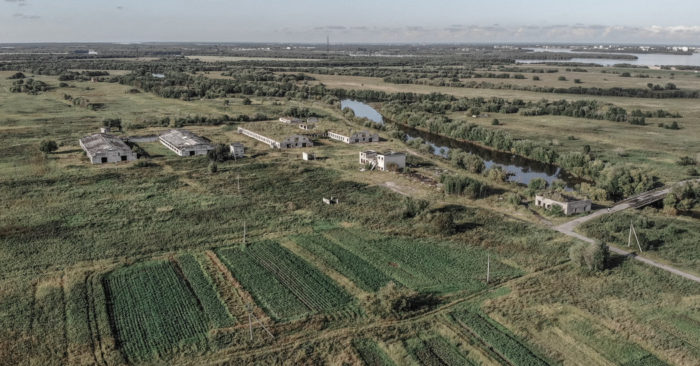
Advertisement
Supported by
Russia Identifies 4 Radioactive Isotopes From Nuclear AccidentImageFarmland on Kegostrov Island, Russia, near where the nuclear accident took place on the White Sea. Sensors reported elevated levels of radiation in the region.CreditCreditMaxim Babenko for The New York Times
By Andrew E. Kramer
Aug. 26, 2019
MOSCOW — A Russian state weather agency named for the first time on Monday four specific radioactive particles released by an explosion at a military testing site earlier this month that left at least seven people dead and has remained shrouded in secrecy weeks after the incident.
The Russian meteorological agency identified them as isotopes of strontium, two types of barium and lanthanum, but asserted that radiation levels are now normal in cities near the accident, which occurred on Aug. 8 in the country’s north.
All four particles form from radioactive gasses released during nuclear fission, outside experts said, and might be expected to drift far from the site of their release.
While shedding little light on the device that exploded earlier this month — or the potential risk to people living nearby — the announcement did offer hints that other, still undisclosed heavier elements could have been released closer to the blast site.
The statement, from an agency whose main task is forecasting weather, came as the latest data point in the gradual drip of information released by the Russian authorities, who have been slow to acknowledge a nuclear accident during a military test.
Western experts and President Trump have suggested the explosion occurred while the Russian military was testing a novel type of cruise missile design that uses nuclear propulsion, which NATO refers to as the Skyfall missile. President Vladimir V. Putin of Russia acknowledged last week that the explosion occurred during a test of a military device.
Both Russia and the United States have ramped up the testing of new delivery systems for nuclear weapons as the disarmament treaties of the late Cold War era break down or expire.
Russian officials have not conceded that the explosion involved the missile called the Skyfall. But on Monday, a Russian diplomat for the first time spoke of the accident in terms of the purpose for such a missile.
The diplomat, Aleksei Karpov, Russia’s envoy to international organizations in Vienna, blamed the United States for setting Russia on the path to developing a new device by withdrawing from an antiballistic missile treaty over 15 years ago.
Mr. Karpov told a gathering of states that are party to the Comprehensive Nuclear Test Ban Treaty that the explosion did not involve a nuclear warhead, and thus did not fall within the treaty’s purview.
Instead, he said, the explosion was “linked to the development of weapons which we had to begin creating as one of the tit-for-tat measures in the wake of the United States’ withdrawal from the Antiballistic Missile Treaty.”
The Russian military initially reported that the Aug. 8 explosion near the village of Nenoksa, on the White Sea in northern Russia, released no contaminants — even as the local authorities at a city about 20 miles away reported a spike in radiation levels.
More misinformation and misdirection soon followed. In Moscow, some television channels blinked out on the night of the accident; screens turned blue and broadcast a warning for residents to remain indoors because of a storm with strong winds. Automated sensors that form part of an international network of radiation monitors, and which may have provided more clues about what happened, mysteriously stopped transmitting results.
Doctors and nurses at a hospital in the city of Arkhangelsk, about 40 miles from the blast, said they were not warned that patients arriving from the site were contaminated with radiation, and treated them without protective clothing.
Later, when one of the doctors was found to have a trace of radioactive cesium 137 in his tissue, the regional government in Arkhangelsk issued a news release saying the contamination was “with some degree of certainty” unrelated to the accident.
The doctor likely ate the element unwittingly in “fish, mushrooms, lichens, seaweed” or another food fouled earlier by fallout from some other, unspecified incident, the statement said.
Officials told the contaminated man he probably ate “Fukushima crabs” while on vacation in Thailand, according to Meduza, an independent news site, citing a fellow doctor at the hospital.
The identification of the four isotopes by the Russian meteorological agency came 18 days after the explosion, and noted that samples taken in the city of Severodvinsk in the 15 days after the explosion contained strontium 91, barium 139, barium 140 and lanthanum 140. Earlier, the same weather agency said a cloud of “inert radioactive gas” had set off radiation meters in the city.
The four isotopes are solids formed from the decay of two radioactive inert gases created from fission of uranium or plutonium, Bruno Chareyron, the laboratory director of CRIIRAD, a French nongovernmental group tracking radiation risks, said in a telephone interview.
The presence of these isotopes miles from the site of the accident, he said, suggested heavier, more dangerous contaminants such as plutonium, cesium 137 or radioactive iodine likely fell into the sea. Greenpeace, the conservation group, issued a statement saying the presence of these isotopes suggested cesium 137 was also released.
“As you have fission products like radioactive gasses, it is logical to think you may have other fission products, too,” Mr. Chareyron said. Without more information, he said, it is impossible to determine the risks to the environment or people living nearby.
A version of this article appears in print on , Section A, Page 6 of the New York edition with the headline: Russia Identifies Four Radioactive Isotopes in Fallout. Order Reprints | Today’s Paper | Subscribe
Advertisement
